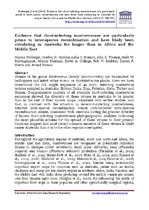| dc.contributor.author | Kraberger, Simona | |
| dc.contributor.author | Harkins, Gordon William | |
| dc.contributor.author | Kumari, Safaa G. | |
| dc.contributor.author | Thomas, John E. | |
| dc.contributor.author | Schwinghamer, Mark W. | |
| dc.contributor.author | Sharman, Murray | |
| dc.contributor.author | Collings, David A. | |
| dc.contributor.author | Briddon, Rob W. | |
| dc.contributor.author | Martin, Darren Patrick | |
| dc.contributor.author | Varsani, Arvind | |
| dc.date.accessioned | 2017-07-12T12:06:23Z | |
| dc.date.available | 2017-07-12T12:06:23Z | |
| dc.date.issued | 2013 | |
| dc.identifier.citation | Kraberger, S. et al. (2013). Evidence that dicot-infecting mastreviruses are particularly prone to inter-species recombination and have likely been circulating in Australia for longer than in Africa and the Middle East. Virology, 444: 282- 291 | en_US |
| dc.identifier.issn | 0042-6822 | |
| dc.identifier.uri | http://hdl.handle.net/10566/3064 | |
| dc.identifier.uri | https://dx.doi.org/10.1016/j.virol.2013.06.024 | |
| dc.description.abstract | Viruses of the genus Mastrevirus (family Geminiviridae) are transmitted by leafhoppers and infect either mono- or dicotyledonous plants. Here we have determined the full length sequences of 49 dicot-infecting mastrevirus isolates sampled in Australia, Eritrea, India, Iran, Pakistan, Syria, Turkey and Yemen. Comprehensive analysis of all available dicot-infecting mastrevirus sequences showed the diversity of these viruses in Australia to be greater than in the rest of their known range, consistent with earlier studies, and that, in contrast with the situation in monocot-infecting mastreviruses, detected inter-species recombination events outnumbered intra-species recombination events. Consistent with Australia having the greatest diversity of known dicot-infecting mastreviruses phylogeographic analyses indicating the most plausible scheme for the spread of these viruses to their present locations, suggest that most recent common ancestor of these viruses is likely nearer Australia than it is to the other regions investigated. | en_US |
| dc.language.iso | en | en_US |
| dc.publisher | Elsevier | en_US |
| dc.rights | This is the author-version of the article published online at: https://dx.doi.org/10.1016/j.virol.2013.06.024 | |
| dc.subject | Mastreviruses | en_US |
| dc.subject | Geminiviruses | en_US |
| dc.subject | Phylogeography | en_US |
| dc.subject | Recombination | en_US |
| dc.title | Evidence that dicot-infecting mastreviruses are particularly prone to inter-species recombination and have likely been circulating in Australia for longer than in Africa and the Middle East | en_US |
| dc.type | Article | en_US |
| dc.privacy.showsubmitter | FALSE | |
| dc.status.ispeerreviewed | TRUE | |
| dc.description.accreditation | Department of HE and Training approved list | |

